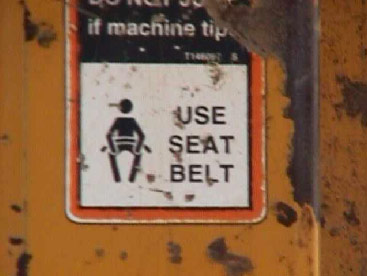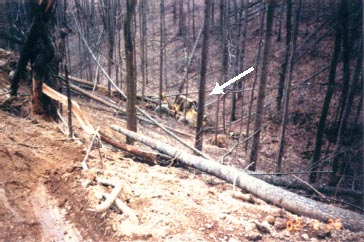
Case: 02WV007-01
Release Date: June 18, 2002
Worker Dies After Being Run Over by the Skidder He was Operating in West Virginia
SUMMARY
On February 26, 2002, an unrestrained 22-year-old male heavy equipment operator (victim) died of injuries sustained when the skidder he was operating ran over him. The victim was using the piece of equipment to drag logs down a skid road to the landing. Approximately 2 weeks before the incident the cab doors had been removed from the skidder for repair. Prior to the fatal incident, the victim had finished lunch and told co-workers he was going back up the hill to get another load of logs. Approximately 30 minutes later, the workers became concerned when the operator did not return with the load. One of the co-workers took a bulldozer up the skid road and discovered the victim lying in the middle of the road. The skidder was spotted over the hill with the load of logs. There were no witnesses, but it was apparent that the skidder, as well as load of logs, had run over the operator. The worker who had discovered the victim returned to the site and told the other worker to call 911. Using his cell phone, he contacted EMS who arrived within 17 minutes of receiving the call. The victim was transported to a medical facility and pronounced dead.
The WV FACE investigator concluded that to reduce the likelihood of similar occurrences, employers should
Additionally, machine operators should
INTRODUCTION
In early March 2002, the WV FACE Program was notified by the West Virginia Bureau of Employment Programs, Workers' Compensation Division of a heavy equipment work-related fatality which had occurred at a logging site. The WV FACE field investigator contacted the West Virginia Division of Forestry (WVDOF) and discussed the case. The WV FACE field investigator and the WVDOF representative traveled to the site on April 2, 2002 and met with the logging company's owner to discuss the incident. The owner then accompanied the investigator to the incident site for further investigation. The piece of equipment was examined and observed while operating. Photographs were also taken at the site. The death certificate and medical examiner's report were obtained, as well as the County Sheriff's Department Investigative Report and photographs.
The privately-owned 60 acre timber stand was being selectively logged for saw timber and pulpwood.
The employer in this incident was a commercial logging company which had been in business for 10 years. At the time of the incident, the workforce totaled 3 including the victim and the owner. The company had a designated safety director (owner) as well as a written safety program. In addition, safety meetings were held weekly and the employer had also administered a skidder operator's written test which the victim passed.
The owner held Certified Logger status in West Virginia. [Note: The Logging Sediment Control Act of West Virginia (1992) requires that each timbering operation in West Virginia be supervised by a certified logger. To become a certified logger, an individual is required to successfully complete training and pass a test for best management practices (a soil erosion prevention plan) and chain saw safety as well as possess a current first aid card.1 ]
The victim's job at the time of the incident was that of skidder operator. He had approximately 3-4 years of experience. He had only been with the company for 3 days when the incident occurred. Prior to hiring him the company owner had contacted the victim's previous employer to check on his work history. Once hired, the victim had received on-the-job observation by the employer to verify his knowledge and skills concerning skidder operation. The owner stated that during the observation period, the victim wore his seatbelt.
He had been skidding approximately 5 hours prior to the incident.
INVESTIGATION
On February 26, 2002, an unrestrained 22-year-old male heavy equipment operator (victim) died of injuries sustained when the skidder he was operating ran over him. The victim was using a 1994 John Deere Model 540E skidder which was purchased new by the company owner. The skidder was originally equipped with cab doors. Approximately 2 weeks before the incident the owner had removed both cab doors for repair. It was reported that they had been bent and he was going to straighten them (see Figure 1). The skidder was also equipped with a seat belt and warning signs which indicated the hazard associated with non-use (see Figure 2). Prior to the fatal incident, the victim had finished lunch and told two co-workers he was going back up the hill to get another load of logs. Approximately 30 minutes later, the workers became concerned when the victim did not return with a load as he had stated he would. One of the workers took a bulldozer up the skid road and discovered the victim lying in the middle of the road (see Figure 3). The skidder, in gear and still running, was over the hill with the load of logs (see Figure 4). There were no witnesses but it was apparent that the skidder as well as the load of logs had run over the operator. The worker who had discovered the victim returned to the site and told the other worker to call 911. Using his cell phone, he contacted EMS who arrived within 17 minutes of receiving the call. The victim was transported to a medical facility and pronounced dead.
CAUSE OF DEATH
The cause of death listed on the death certificate was multiple crush injuries.
RECOMMENDATIONS/DISCUSSION
Recommendation #1: Employers should ensure that machines are maintained in a safe and serviceable condition.
Discussion: Equipment owners should realize the correlation between defective equipment and risk-taking. The skidder's cab doors were in a state of disrepair and removed by the owner. The owner had inappropriately allowed the machine to be operated without the doors. Operating skidders without the doors or with the doors tied open are unsafe practices, especially when operators are not wearing their seat belts. Equipment should be inspected regularly and defects or damage repaired or the unserviceable machines should be pulled from service or replaced. The OSHA Logging Standard CFR 1910.266 (f)(1)(ii) requires that defects or damage shall be repaired or the unserviceable machine shall be replaced before work is commenced. 2
Had this skidder's cab doors been present and latched the operator would likely have remained inside the cab and would not have been run over by the machine and its load.
Recommendation #2: Machine operators should always wear their seatbelt while operating machines.
Discussion: The owner reported that during the first day of employment the victim had received on-the-job observation by the owner himself to verify his knowledge and skills concerning skidder operation. The owner stated that during this observation period, the victim consistently wore his seatbelt, complying with the warning sign within the skidder cab. Shortly before the incident, the operator either forgot or made the conscious decision not to wear his seat belt which directly violates the manufacturer's recommendations. The OSHA Logging Standard CFR 1910.266 (f)(1)(iii) requires that each machine operator comply with the operating instructions. 2 The value of wearing a seat belt will be realized when the operator least expects it. Had the operator continued his normal practice of using his seatbelt, he would have remained within the cab and the fatal incident would have been avoided.
REFERENCES:
ILLUSTRATIONS

Figure 1. This is the skidder which ran over the victim. The arrow points to one of two doors which were not present the day of the incident.

Figure 2. Warning sign located inside of the cab.

Figure 3. This is where the victim was found lying in the road.

Figure 4. The arrow points to the skidder's final resting place.
FATALITY ASSESSMENT AND CONTROL EVALUATION PROGRAM
The WVU Center for Rural Emergency Medicine, through a contract with the West Virginia Department of Health and Human Resources and Bureau for Public Health, conducts investigations on the causes of work-related fatalities within the state. The goal of this program is to prevent future fatal workplace injuries. West Virginia FACE intends to achieve this goal by identifying and studying the risk factors that contribute to workplace fatalities, by recommending intervention strategies, and by disseminating prevention information to employers, employees, trade associations, unions, equipment manufacturers, students, teachers, and others with an interest in workplace safety.
Please use information listed on the Contact Sheet on the NIOSH FACE website to contact In-house FACE program personnel regarding In-house FACE reports and to gain assistance when State-FACE program personnel cannot be reached.